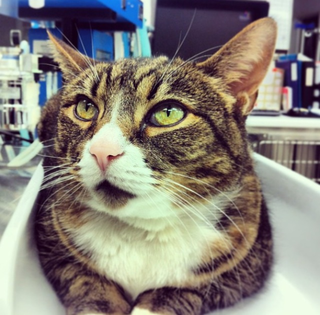Since calling Amherst Veterinary Hospital her home for the last year and a half, Mary has been treated for a multitude of ailments including numerous ear infections, chronic GI upset and a bout of pancreatitis that involved surgically placing a feeding tube. Along with all of these issues, we first met Mary as an obese, diabetic cat. Despite all of this, Mary always seems to make a full recovery. Perhaps our most successful recovery with Mary is her remission from diabetes not once, but twice!
November is Pet Diabetes Month, so in honor of this we thought we would write about our lovely Mary and her experience with Diabetes. Many people don’t realize that our pets, just like us, can develop diabetes.
Mary’s journey to Amherst Veterinary Hospital began about a year and half ago when she was diagnosed with diabetes. She was brought to the hospital because she was drinking more water than usual and had been urinating inappropriately all over the house. We collected a blood and urine sample and sent it off to the lab. Her results came back; her blood sugar was high above normal range (hyperglycemia), her urine showed high presence of glucose and her fructosamine was elevated; Miss Mary was diabetic.

When Mary first came to us, overweight and diabetic.
With this diagnosis Mary’s owners did not feel they could adequately provide the care that she needed and were considering euthanasia. Diabetes in cats is a very manageable disease and with the proper insulin and food many cats go into remission (they stop being diabetic). So instead of euthanizing Mary, we asked her owners if they would allow us to adopt her. They agreed, and Mary moved into the clinic. She was started on twice daily insulin injections and was monitored closely for urine output, water intake and appetite. She was also started on a special canned diet formulated for diabetic animals.

Testing kit used to check Mary’s blood glucose levels.
For six months Mary was closely monitored. We kept an eye on her weight and routinely checked her blood and urine to measure her glucose levels. Her insulin was adjusted based on these results. Until we found Mary’s urine to be consistently free of glucose and her blood sugars to be normal. We stopped the daily insulin injections, and after a couple days without insulin we sent a blood and urine sample to the lab. The results: Mary was in remission!
And so, for three blissful months our Mary was diabetes free! She could once again spend her day’s needle free, leisurely roaming the clinic, begging for food. She was still closely monitored, her strict diet was maintained and we continued to check her blood sugar levels and urine for glucose every 4-6 weeks. Until one routine blood glucose test showed an increase in sugar levels. Poor Mary had become diabetic again and was back to receiving two shots of insulin a day.
One morning, about two months after becoming diabetic for the second time, Mary turned her nose at her breakfast. Now, this is a very rare occurrence, Mary LOVES food. Mary is always hungry, even if she’s just eaten one of the four scheduled meals she receives every day. Mary will try to fool people into feeding her, she will beg for food, try to steal food…you get the idea. So when Mary would not eat we alerted our doctors who stopped Mary’s insulin until her blood work results were back. Lo and behold, her blood glucose was normal! Mary was in diabetic remission for the second time.

Mary now, at a healthy weight and diabetes free!
Mary has been diabetes free and regulating her own insulin levels for 8 glorious months. We still keep her on a strict diet, ensure her weight is healthy, and whenever we notice a change in behavior you can be sure we are running some tests to make sure everything checks out.
What is Diabetes?
Diabetes Mellitus is a condition where the body does not produce enough insulin (Type 1 diabetes) or cannot make use of the secreted insulin properly (Type 2 diabetes). Insulin is a hormone that controls blood sugar in the body. It helps the cells of the body to use sugar or glucose for energy. Normally, when your pet eats, the food is turned into glucose and the pancreas secretes insulin to allow the body to convert the glucose into energy to maintain normal body functions. When an animal is diabetic their cells are essentially starving of the glucose they need to function.
In a diabetic animal:
- the cells cannot receive glucose from the blood
- the body is unable to detect the glucose in the blood and therefore thinks it’s starving
- proteins, starch and fat break downs occur as if the body is starving
- there is now a large excess of sugar in the bloodstream
- the kidneys are unable to handle the large amount of glucose and it spills into the urine (normal kidneys would be able to prevent this loss)
- glucose draws water with it resulting in a excess urination and drinking
Therefore the clinical signs of a diabetic animal are:
- excessive eating
- excessive drinking
- excessive urination
- weight loss
Although treating a pet with diabetes does require dedication from the owner, dogs can be managed very well with insulin injections and can have a great long term prognosis. In cats the prognosis is even better in that many will achieve diabetic remission after several months of treatment. For more information on Diabetes such as treatment, monitoring and risks visit https://amherstvethospital.com/diabetes-risk-factors-treatment-and-monitoring/

